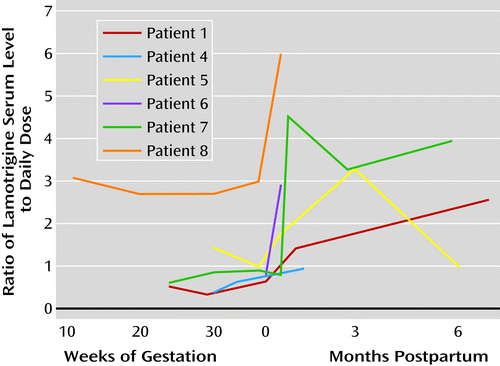In This Issue

Lamotrigine serum levels decline during pregnancy as drug clearance increases. In pregnant women with bipolar disorder, measuring the serum level every 4 weeks and increasing the dose 20%–25% as needed can help maintain the target serum level and reduce bipolar symptoms. After delivery, lamotrigine clearance decreases and toxicity becomes a possibility. Thus, the serum concentration should be measured every 1–2 weeks and the dose reduced incrementally until the prepregnancy serum level is reached. Breast-fed infants should also be monitored for toxicity, as lamotrigine is transferred in breast milk. Clark et al. (p. Original article: 1240) highlight the considerable interindividual variation in lamotrigine metabolism in both infant and mother (figure).
Intermediate Phenotypes in Psychotic Disorders
Quantitative, diagnosis-independent traits, known as intermediate phenotypes or endophenotypes, may identify more homogeneous patient groups than do psychiatric diagnoses. The Bipolar-Schizophrenia Network on Intermediate Phenotypes (B-SNIP) examined potential intermediate phenotypes in probands with schizophrenia, bipolar disorder with psychosis, or schizoaffective disorder and in their relatives and healthy subjects. Tamminga et al. (p. Original article: 1263) found that symptoms and psychosocial functioning were generally worse in schizophrenia probands than in probands with the other diagnoses, but there was considerable overlap. Likewise, many families contained both schizophrenia and bipolar diagnoses. Hill et al. (p. Original article: 1275) report increasingly severe cognitive impairment from bipolar disorder to schizoaffective disorder to schizophrenia. Family rates of cognitive deficits were comparable in schizophrenia and bipolar disorder, but in bipolar disorder the deficits mainly affected relatives with cluster A or cluster B personality traits. Measurements of gray matter volume by Ivleva et al. (p. Original article: 1285) showed differences between psychotic and nonpsychotic individuals and between diagnoses: schizophrenia and schizoaffective probands had overlapping areas of low gray matter volume in numerous cortical and subcortical regions, whereas bipolar probands had fewer low-volume areas. The editorial by Frangou (p. Original article: 1223) notes that structural imaging reflects the static brain configuration, whereas cognitive performance is an expression of a dynamic configuration.
Antidepressants should be prescribed for bipolar I patients only as an adjunct to mood-stabilizing medication, since antidepressant-related mood elevations are more common in bipolar I than bipolar II disorder. Serotonin reuptake inhibitors and bupropion appear to be less likely to trigger a mania switch than tricyclics and norepinephrine-serotonin reuptake inhibitors. Maintenance treatment with adjunctive antidepressants may be considered if a patient becomes depressed after acute treatment ends. Bipolar patients beginning antidepressant treatment should be closely monitored for mania symptoms. Pacchiarotti et al. (p. Original article: 1249) present a task force report but note that evidence is still limited.
Many patients diagnosed as having panic disorder with agoraphobia benefit from cognitive-behavioral therapy (CBT) even if they do not respond fully, but functional brain imaging provides clues about who is likely to improve most. Lueken et al. (p. Original article: 1345) compared pretreatment responses to a fear-conditioning task in CBT responders and nonresponders. Nonresponders had greater neural responses to a safety signal, raising the possibility that CBT may not be as effective for patients with a bias toward detecting threat. Successful treatment was associated with a posttreatment increase in hippocampal activation during processing of stimulus contingencies. This suggests awareness of stimulus-outcome associations, another quality that may help identify patients who will benefit the most from CBT. Editorialist Henn (p. Original article: 1235) cites deep brain stimulation for depression as an example of how knowledge of brain circuits can inform treatment.



